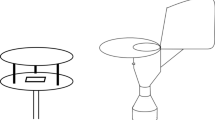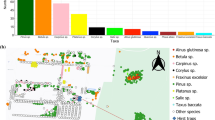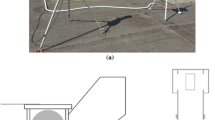Abstract
The aspiration efficiency of vertical and wind-oriented Air-O-Cell samplers was investigated in a field study using the pollen of hazel, sweet chestnut and birch. Collected pollen numbers were compared to measurements of a Hirst-type Burkard spore trap. The discrepancy between pollen counts is substantial in the case of vertical orientation. The results indicate a strong influence of wind velocity and inlet orientation relative to the freestream on the aspiration efficiency. Various studies reported on inertial effects on aerosol motion as function of wind velocity. The measurements were compared to a physically based model for the limited case of vertical blunt samplers. Additionally, a simple linear model based on pollen counts and wind velocity was developed. Both correction models notably reduce the error of vertically oriented samplers, whereas only the physically based model can be used on independent datasets. The study also addressed the precision error of the instruments used, which was substantial for both sampler types.








Similar content being viewed by others
References
Aizenberg V, Reponen T, Grinshpun S, Willeke K (2000) Performance of Air-O-Cell, Burkard and Button Samplers for total enumeration of airborne spores. Am Ind Hyg Assoc J 61:855–864
Armbruster L, Breuer H (1982) Investigations into defining inhalable dust. Pergamon, Oxford, pp 3–19
Badzioch S (1959) Collection of gas-borne dust particles by means of an aspirated sampling nozzle. Br J Appl Phys 10:26–32
Belyaev S, Levin L (1974) Techniques for collection of representative aerosol samples. J Aerosol Sci 5:325–338
Birks H (1968) The identification of betula nana pollen. New Phytol 67:309–314
Bucher E, Kofler V, Vorwohl G, Zieger E (2004) Das Pollenbild der Südtiroler Honige. Landesagentur für Umwelt und Arbeitsschutz, Biologisches Labor
Cariñanos P, Emberlin J, Galán C, Domínguez-Vilches E (2000) Comparison of two pollen counting methods of slides from a hirst type volumetric trap. Aero 16:339–346
Comtois P, Alcazar P, Neron D (1999) Pollen counts statistics and its relevance to precision. Aerobiologia 15:19–28
Dunnett S, Wen X, Zaripov S, Galeev R, Vanunina M (2006) A numerical study of calm air sampling with a blunt sampler. Aerosol Sci Technol 40:490–502
Durham M, Lundgren D (1980) Evaluation of aerosol aspiration efficiency as function of stokes number, velocity ratio and nozzle angle. J Aerosol Sci 11:179–188
Frenz D (1999) Comparing pollen and spore counts collected with the Rotorod sampler and Burkard spore trap. Ann Allergy Asthma Immunol 83:341–347
Gottardini E, Cristofolini F, Cristofori A, Vannini A, Ferretti M (2009) Sampling bias and sampling errors in pollen counting in aerobiological monitoring in Italy. J Environ Monitor 11:751–755
Grinshpun S, Lipatov G (1990) Sampling errors in cylindrical nozzles. Aerosol Sci Technol 12:716–740
Grinshpun S, Chang CW, Nevalainen A, Willeke K (1994) Inlet characteristics of bioaerosol samplers. J Aerosol Sci 25(8):1503–1522
Hangal S, Willeke K (1990a) Aspiration efficiency: unified model for all forward sampling angles. Environ Sci Technol 24:688–691
Hangal S, Willeke K (1990b) Overall efficiency of tubular inlets sampling at 0–90 degrees from horizontal aerosol flows. Atmos Environ 24A:2379–2386
Hirst J (1952) An automatic volumetric spore trap. Ann Appl Biol 39:257–265
Levetin E (2004) Methods for aeroallergen sampling. Curr Allergy Asthma Rep 4:376–383
Lipatov G, Grinshpun S, Semenyuk T, Sutugin A (1988) Secondary aspiration of aerosol particles into thin-walled nozzles facing the wind. Atmos Environ 22:1721–1727
Lundgren D, Durham M, Mason K (1978) Sampling of tangential flow streams. Am Ind Hyg Assoc J 39:640644
Mandrioli P, Comtois P, Levizzani V (1998) Methods in aerobiology. Pitagora Editrice, Bologna, Italy
Michel D, Gehrig R, Rotach M, Vogt R (2010) Micropoem: experimental investigation of birch pollen emission. In: 19th Symposium on Boundary Layer and Turbulence, 2–8 August, Keystone, Colorado
Ogden T, Birkett J (1977) The human head as a dust sampler. Pergamon, Oxford, pp 93–105
Ogden E, Raynor G, Hayes J, Lewis D, Haines J (1974) Manual for sampling airborne pollen. Hafner, New York
Paik S, Vincent J (2002) Aspiration efficiency for thin-walled nozzles facing the wind and for very high velocity ratios. J Aerosol Sci 33:705720
Tsai P, Vincent J (1993) Impaction model for the aspiration efficiencies of aerosol samplers at large angles with respect to the wind. J Aerosol Sci 24:919–928
Vincent J (1989) Aerosol sampling: science and practice. Wiley, Chichester
Vincent J (2007) Aerosol sampling: science, standards, instrumentation and applications. Wiley, Chichester
Vincent J, Stevens D, Mark D, Marshall M, Smith T (1986) On the spiration characteristics of large-diameter, thin-walled aerosol sampling probes at yaw orientations with respect to the wind. J Aerosol Sci 17:211–224
Wiener R, Okazaki K, Willeke (1988) Influence of turbulence on aerosol sampling efficiency. Atmos Environ 22:917–928
Acknowledgments
Our great appreciation goes to the European Cooperation in Science and Technology (COST) Action ES0603. Financial support for this project by the Swiss State Secretariat for Education and Research (SBF), grant C07.0111, and the Freiwillige Akademische Gesellschaft Basel, is gratefully acknowledged. Many thanks go to MeteoSwiss and the MCR Lab, University of Basel. Their contribution to the field campaigns and the pollen analysis is highly appreciated. The comments of an anonymous reviewer to a first draft of the present paper led to a substantial improvement of the results from this study and are greatly acknowledged.
Author information
Authors and Affiliations
Corresponding author
Rights and permissions
About this article
Cite this article
Michel, D., Rotach, M.W., Gehrig, R. et al. On the efficiency and correction of vertically oriented blunt bioaerosol samplers in moving air. Int J Biometeorol 56, 1113–1121 (2012). https://doi.org/10.1007/s00484-012-0526-x
Received:
Revised:
Accepted:
Published:
Issue Date:
DOI: https://doi.org/10.1007/s00484-012-0526-x




